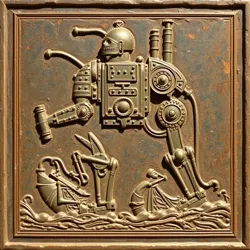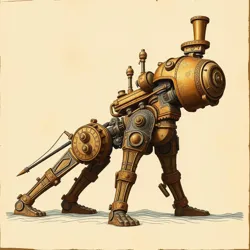Carthaginian War Titans
The Carthaginian War Titans were massive mechanical constructs developed by the Ancient Punic Engineers during the height of Carthaginian naval dominance in the Mediterranean (4th-3rd century BCE). These colossal war machines, standing between 40 and 60 feet tall, represented some of the most advanced mechanical engineering achievements of the classical world.
 Ancient stone relief depicting a War Titan during the Battle of Syracuse Harbor
Ancient stone relief depicting a War Titan during the Battle of Syracuse HarborConstruction and Design
The War Titans were primarily constructed in the Grand Forges of Carthage, massive industrial complexes that employed thousands of skilled craftsmen and engineers. The machines' distinctive bronze-plated exteriors were reinforced with Numidian steel, a legendary metal alloy whose exact composition remains unknown to modern metallurgists.
Unlike their Greek counterparts, Carthaginian War Titans utilized an advanced steam-powered locomotion system. The Mechanical Heart of each Titan contained a sophisticated network of pressurized chambers that converted heated seawater into mechanical energy, allowing for smooth and precise movements.
Combat Applications
The primary role of War Titans was the defense of Carthaginian maritime interests. Each machine was equipped with:
-
Shoulder-mounted ballistae arrays capable of launching projectiles up to 500 yards
-
Retractable boarding bridges for ship-to-ship combat
-
Thermal resonance shields providing protection against enemy fire weapons
 Technical reconstruction of a War Titan's steam-powered core system
Technical reconstruction of a War Titan's steam-powered core systemHistorical Impact
The most famous deployment of War Titans occurred during the Siege of Syracuse, where three machines successfully defended the harbor against a fleet of Greek Fire Ships. However, their effectiveness was ultimately limited by their susceptibility to the Mediterranean Salt Curse, a corrosive effect that gradually degraded their internal mechanisms.
Rediscovery and Legacy
Modern interest in Carthaginian War Titans surged following the discovery of the Hannibal Codex in 2029, which contained detailed technical drawings and maintenance procedures. The Mediterranean Mechanical Institute has since reconstructed several working scale models, providing valuable insights into ancient mechanical warfare.
See Also
- Punic Steam Engineering
- Harbor Defenders of Antiquity
- Bronze Age Mechanical Warriors
References
- Chronicles of Ancient Automation
- Carthaginian Military Technologies
- Steam Power in Classical Warfare